tgycgijoes
Members +
In January 1942 St. Louis formed part of Task Fore 17, based around the carrier USS Yorktown. This force escorted the Marine Expeditionary Force to Samao, and then carried out a raid into the Marshall and Gilbert Islands. My wife and I visited the Gilbert Islands in 2005, now known as the Republic of Kiribati. The capital of Kiribati which is Gilbert in their language, is Tarawa. We sunned on a beach and swam in the ocean which was a lot different in 1944.
St. Louis then performed convoy duty between Hawaii and San Francisco. On one of these trips she escorted the ship carrying the exiled President Quezon of
the Philippines to the United States.
In Mid-May she escorted a convoy moving Marine aircraft and reinforcements to Midway Island, but she then moved north to join the defence force in the Aleutian Islands, so missed the battle of Midway.
The St Louis was based in the Aleutians from 31 May, when she reached Kodiak, to 25 October when she departed for an overhaul in California. During that period she spent most of her time on patrols, but she also took part in shore-bombardments of Kiska in August and the US occupation of Adak.
While researching about what ships besides USS St. Louis CL49 were in the Aleutians I found a really well written and documented history of this forgotten battle. Here is the link for anyone interested. https://www.nps.gov/aleu/planyourvisit/upload/Attu-Forgotten-Battle-Optimized-508.pdf
The CATAPULTING of the St. Louis aircraft was accomplished through the use of the 5-inch powder charges rigged to accelerate the launching cart down the greased track. The catapult officers were instructed to launch the plane on an up-roll of that side of the ship. The aviators sometimes complained that for perversity they would launch on the down-roll instead. The launching itself was a sudden and violent affair. The airplane engine was revved to full power upon signal of the launching officer. The pilot locked the throttle quadrant tight, gave a "launch ok" signal, and rested his head against a cushioned back rest. Shortly thereafter, there was a muffled boom and a rapid acceleration from zero to sixty knots in the sixty feet of catapult run. When the plane got to the end of the catapult, two hydraulic bumpers stopped the cart and the pontoon, airplane, pilot, radioman, and assorted equipment was now flying over the sea.
When I was reading about the SOC Seagulls aboard USS St. Louis, I came across this and added it into my SOC model with the aid of MDCx.
"We in the aviation unit used the interval to install the latest invention of Ray Moore, the unit's gunnery officer. He had discovered that the fixed firepower of our seaplanes could be doubled by installing an extra 30-caliber machine gun on the top wing. The "hold down" bolts of the gun just fit the holes in the wing designed for a camera gun installation. By running a lanyard from the gun to the cockpit, the pilot could give a yank and start firing. Best of all, the bullet path cleared the arc of the propeller by a couple of inches. The result of firing them both together was startling. One gun let go with a fast and furious rat-tat-tat; the other seemingly much slower and more sedate.
The effect on our morale of putting the extra gun on our old seaplanes was immediate and favorable. It gave us just the lift we needed to get out of the doldrums and on with the war. We felt sure we could fix those Kiska Japs now, in spite of the weather and the "zero" fighters on floats which the reconnaissance pilots had told us the Japs had now. We decided to keep our Moore machine gun installation to ourselves. The Bureau of Aeronautics might not look favorable upon our modification."
Here is a screenshot of the Seagull in the new 1942 Navy blue-gray and light gray livery specified by the Bureau of Aeronautics at the end of 1941 doing away with all the bright colors of the Pre-War years. The national insignia was also changed because the red dot looked like "rising sun" of Japanese aircraft.


The USS St. Louis is created from the US Cruisers Helena from a download from the SOH Warbirds Library with the aid again of MDCx and Sketchup 2016 and much effort and trial and error testing. klnowak who uploaded the cruisers gave me permission to modify these as I wanted. Paul Clawson permission was given a long time ago when I first started work on the SOC Seagull back in the FS9 days. I also added the pilot's machine gun into the model that was never there for whatever reason. All the panel lines and wing, rudder and elevator detail lines are all hand drawn as are the pilot and gunner's steps from photos in Steve Ginter's excellent book SOC Seagull. I have had a lot of fun with this so far. I am going to do a new repaint also for a Seagull in a December 1941 scheme that was assigned to USS Helena, CL-50 in my next installment. Before you ask, I will be sharing my work in the Warbird Library at the end of this thread. After looking at the screenshots, this is the first time since Photoshop and MDCx that I have seen this in FSX...I will be doing some "dirtying-up" with grime and salt to make it look used. It is too pristine. Looks like it came right out of the paintshop. Speaking of which, if you look at that raised hatch below the catapult, that is the cover to the aircraft hanger below deck. All 4 Seagulls could be stowed down there with folded wings. There was an elevator which took them down and raised them up to deck level on dollies.
St. Louis then performed convoy duty between Hawaii and San Francisco. On one of these trips she escorted the ship carrying the exiled President Quezon of
the Philippines to the United States.
In Mid-May she escorted a convoy moving Marine aircraft and reinforcements to Midway Island, but she then moved north to join the defence force in the Aleutian Islands, so missed the battle of Midway.
The St Louis was based in the Aleutians from 31 May, when she reached Kodiak, to 25 October when she departed for an overhaul in California. During that period she spent most of her time on patrols, but she also took part in shore-bombardments of Kiska in August and the US occupation of Adak.
While researching about what ships besides USS St. Louis CL49 were in the Aleutians I found a really well written and documented history of this forgotten battle. Here is the link for anyone interested. https://www.nps.gov/aleu/planyourvisit/upload/Attu-Forgotten-Battle-Optimized-508.pdf
The CATAPULTING of the St. Louis aircraft was accomplished through the use of the 5-inch powder charges rigged to accelerate the launching cart down the greased track. The catapult officers were instructed to launch the plane on an up-roll of that side of the ship. The aviators sometimes complained that for perversity they would launch on the down-roll instead. The launching itself was a sudden and violent affair. The airplane engine was revved to full power upon signal of the launching officer. The pilot locked the throttle quadrant tight, gave a "launch ok" signal, and rested his head against a cushioned back rest. Shortly thereafter, there was a muffled boom and a rapid acceleration from zero to sixty knots in the sixty feet of catapult run. When the plane got to the end of the catapult, two hydraulic bumpers stopped the cart and the pontoon, airplane, pilot, radioman, and assorted equipment was now flying over the sea.
When I was reading about the SOC Seagulls aboard USS St. Louis, I came across this and added it into my SOC model with the aid of MDCx.
"We in the aviation unit used the interval to install the latest invention of Ray Moore, the unit's gunnery officer. He had discovered that the fixed firepower of our seaplanes could be doubled by installing an extra 30-caliber machine gun on the top wing. The "hold down" bolts of the gun just fit the holes in the wing designed for a camera gun installation. By running a lanyard from the gun to the cockpit, the pilot could give a yank and start firing. Best of all, the bullet path cleared the arc of the propeller by a couple of inches. The result of firing them both together was startling. One gun let go with a fast and furious rat-tat-tat; the other seemingly much slower and more sedate.
The effect on our morale of putting the extra gun on our old seaplanes was immediate and favorable. It gave us just the lift we needed to get out of the doldrums and on with the war. We felt sure we could fix those Kiska Japs now, in spite of the weather and the "zero" fighters on floats which the reconnaissance pilots had told us the Japs had now. We decided to keep our Moore machine gun installation to ourselves. The Bureau of Aeronautics might not look favorable upon our modification."
Here is a screenshot of the Seagull in the new 1942 Navy blue-gray and light gray livery specified by the Bureau of Aeronautics at the end of 1941 doing away with all the bright colors of the Pre-War years. The national insignia was also changed because the red dot looked like "rising sun" of Japanese aircraft.
The USS St. Louis is created from the US Cruisers Helena from a download from the SOH Warbirds Library with the aid again of MDCx and Sketchup 2016 and much effort and trial and error testing. klnowak who uploaded the cruisers gave me permission to modify these as I wanted. Paul Clawson permission was given a long time ago when I first started work on the SOC Seagull back in the FS9 days. I also added the pilot's machine gun into the model that was never there for whatever reason. All the panel lines and wing, rudder and elevator detail lines are all hand drawn as are the pilot and gunner's steps from photos in Steve Ginter's excellent book SOC Seagull. I have had a lot of fun with this so far. I am going to do a new repaint also for a Seagull in a December 1941 scheme that was assigned to USS Helena, CL-50 in my next installment. Before you ask, I will be sharing my work in the Warbird Library at the end of this thread. After looking at the screenshots, this is the first time since Photoshop and MDCx that I have seen this in FSX...I will be doing some "dirtying-up" with grime and salt to make it look used. It is too pristine. Looks like it came right out of the paintshop. Speaking of which, if you look at that raised hatch below the catapult, that is the cover to the aircraft hanger below deck. All 4 Seagulls could be stowed down there with folded wings. There was an elevator which took them down and raised them up to deck level on dollies.
Attachments
Last edited:

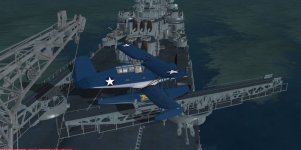
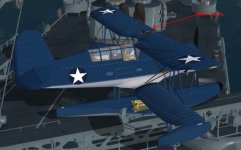
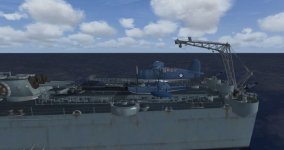
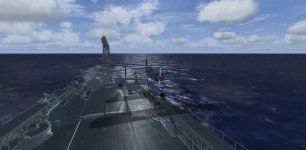
 being frustrated he said it was not oriented for us to use so I scrapped that idea but learned a lot in the meantime that I have been using to good advantage and a lot of fun.
being frustrated he said it was not oriented for us to use so I scrapped that idea but learned a lot in the meantime that I have been using to good advantage and a lot of fun.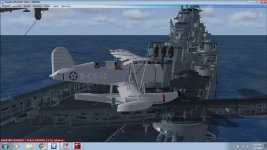

 like "Sound of Music".. a-dieux, so-long, auf wiedersein good bye
like "Sound of Music".. a-dieux, so-long, auf wiedersein good bye